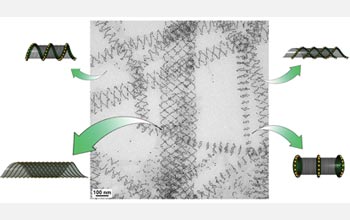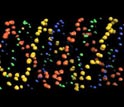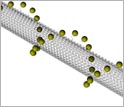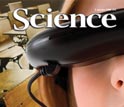|

Press Release 08-221
Mother Nature Knows Nano

Scientists use DNA and gold particles to engineer nanotube structures
January 1, 2009
View a video of the 3D architecture of nanotubes formed with 5 nm and 10 nm AuNPs (gold particles).
The future of the nanotechnology field depends on our ability to reliably and reproducibly assemble nanoparticles into 3D structures we can use to develop new technologies. According to Hao Yan and Yan Liu at Arizona State University, the greatest challenges in this burgeoning field include control over nanoscale 3D structure and imaging these tiny materials. "The ability to build predicted structures and provide experimental feedback to current theories is critical to the nanotechnology field," said Yan. One approach to production of nanoscale architecture is creation of nanoparticles that assemble themselves into the desired structure. DNA molecules are an elegant biological example of small particles that self-assemble to form higher order 3D structures. Inspired by this prototype, Yan and colleagues looked to Mother Nature to solve their nano-sized problem. They attached gold nanoparticles to DNA, taking advantage of its self-assembling biochemical properties to engineer nanotubes that form a number of different 3D structures. The researchers manipulated nanotube size and shape by changing the size of the gold particles attached to the DNA or the DNA structure itself. Anchi Cheng at the Scripps Research Institute contributed to the project by imaging the 3D conformations of nanotube structures using cryo-Electron Tomography This National Science Foundation-supported research is published in the January 2 issue of Science magazine. Yan is hopeful this groundbreaking work will serve as the foundation on which emerging fields and new technologies may be built. "Now that we have methods to alter the periodicity, diameter and chirality of nanotube formation, we can use what we have learned to control hierarchical assembly of these building blocks to create more complex 3D structures," he said. In the future, use of nanotubes may reduce the size of cell phones and other electronic devices even further. Scientists also envision using nanotubes for a number of biological applications including gene and drug delivery. Drugs or other treatments specifically delivered using nanotubes would target only affected tissues, potentially eliminating toxic side effects.
-NSF-

Media Contacts
Bobbie Mixon, NSF (703) 292-8070 bmixon@nsf.gov
Lisa Van Pay, NSF (703) 292-8796 lvanpay@nsf.gov
Principal Investigators
Hao Yan, Arizona State University (480) 727-8570 hao.yan@asu.edu

The National Science Foundation (NSF) is an independent federal agency that
supports fundamental research and education across all fields of science and
engineering, with an annual budget of $6.06 billion. NSF funds reach all 50
states through grants to over 1,900 universities and institutions. Each year,
NSF receives about 45,000 competitive requests for funding, and makes over
11,500 new funding awards. NSF also awards over $400 million in
professional and service contracts yearly.
 Get News Updates by Email Get News Updates by Email
Useful NSF Web Sites:
NSF Home Page: http://www.nsf.gov
NSF News: http://www.nsf.gov/news/
For the News Media: http://www.nsf.gov/news/newsroom.jsp
Science and Engineering Statistics: http://www.nsf.gov/statistics/
Awards Searches: http://www.nsf.gov/awardsearch/
| 




